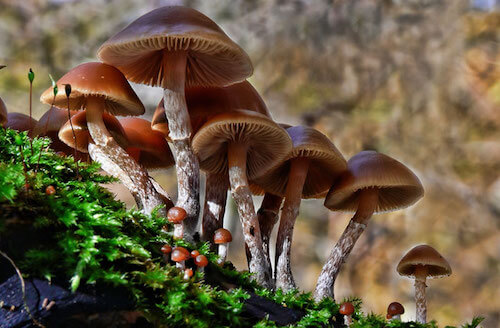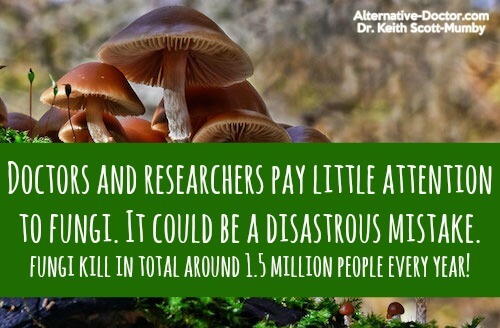Fungi are a rum bunch: we can eat some and they are delicious (cèpes, chanterelles, truffles); others are deadly (Deathcap (Amanita phalloides), Avenging angel, Autumn skullcap). Some even make fabulous medicines (Lion’s mane, Turkey tail, Shiitake and Maitake).
 Delicious cèpes, one of my favorite culinary mushrooms
Delicious cèpes, one of my favorite culinary mushrooms
 Deadly Autumn skullcap (Galerina marginata), destroyer of livers!
Deadly Autumn skullcap (Galerina marginata), destroyer of livers!
Some Benefits of Mushrooms and Fungi
We live in an uneasy peace with mushrooms and fungi. In fact not so much peace as we shall see. But fungi can do good things:
- They can tackle oil spills, break down pesticides and herbicides, as Paul Stametz has taught us, and even destroy neurotoxins used in chemical weapons.
- Fungi play a crucial role in ecosystems by feeding off organic matter and recycling the nutrients for plants to use. In fact without fungi the world would soon be one gigantic rotting garbage heap of dead matter.
- Fungi produce antibiotics, most famously penicillin, and are used to make other drugs – even antifungals. They also synthesize complex compounds of commercial drugs.
Fungi On The March
Fungi are on the march against us.
It would come as a shock to most people to learn that fungi kill in total around 1.5 million people every year. That’s more than Malaria (dropped steadily from 850,000 per annum to 440,000 approximately). Fungal disease is a significant contributor to AIDS deaths, for example (50%).
Fungal infections are often overlooked and a diagnosis of bacterial disease made instead. So the actually figures are probably far higher!
New fungal varieties are emerging and infecting everything from crops to amphibians. Some of this is down to the ease of international travel, which spreads hardy spores to new locations. Then there’s our disruption of natural environments, which creates opportunities for fungi to evolve. Now, some researchers are worried we could be about to reap the spores we’ve sown: might we have unleashed a killer “perfect storm”?

Paul Stamets
Paul Stamets is “Mr. Fungus”. He makes mycology exciting and sexy. Everyone should read his book Mycelium Running: How Mushrooms Can Help Save the World. The largest living organism on Earth, Stamets tells us, is a humongous honey fungus (Armarillia) mycelium growing in the Blue Mountains of Oregon; it’s 2.4 miles across (3.5 km)!1
A mycelium is a network of fungal cells threaded together to create long, forking chains, in a complex fabric of cells permeating virtually all land masses of Earth, from the tundra to the tropical rainforests.
He writes about cool stuff, like water filtration, and cleaning up oil spills, using fungi. Mycelium can be grown on woodchips and placed into burlap sacks to filter water run-off, which can contain petroleum products, heavy metals and toxic bacteria. Oil spills, which are very toxic to the environment, can be rendered absolutely safe in just 6 weeks and all the toxic debris gets turned into usable garden soil and compost. A miracle!
 Paul Stamets with parasol mushrooms
Paul Stamets with parasol mushrooms
Back To The Dangers of Fungi
OK, enough of the “mycology tourism”! Let’s get back to the problems.
Fungi comprise a whole kingdom of organisms in their own right, separate from plants and animals, and far less studied. This hugely diverse group of up to 5 million species includes mushrooms, yeasts, molds and crop-destroying rusts and smuts. Most of the time, we happily coexist even with the killer varieties – you may be inhaling them right now, or they may be living in or on your body. But occasionally they turn rogue.
Candida albicans causes most fungal infections in humans, including thrush. 100 million women worldwide suffer at least four episodes of vaginal thrush a year. Mostly it’s a harmless nuisance but if the patient is even slightly immune-compromised Candida multiplies so fast that it can cause an overwhelming fatal infection.
The bloodstream of a healthy human is quite robust to infections,” says Neil Gow, a medical mycologist at the University of Aberdeen, UK, in an interview for New Scientist. But Candida does overcome the defences of hundreds of thousands of people each year to enter their blood – and at least half of them die. How can this be?
“In a way, fungal infections are the disease of the diseased,” says Gow. “People who are vulnerable after an accident or invasive surgery, or whose immune system has been weakened or suppressed after an organ or stem cell transplant, may be unable to fend off a fungal attack. Candida is very opportunistic.”
Even when it does end up inside a white blood cell, it’s not necessarily the end. “The fungus can evade digestion by reducing the acidity inside the cell compartment where it’s held, and it even scavenges some of the cell’s food,” says Gow – “which is why it’s often able to keep growing until the white blood cell bursts open.”2
Cryptococcus
Another potentially deadly fungus, Cryptococcus, can cause meningitis by lurking in a white blood cell until it crosses the usually impenetrable blood-brain barrier. It then forces the cell to eject it.
Unlike Candida, Cryptococcus is not a fungus native to us – instead, it usually grows on rotting plant material in the soil. Though most of us have been exposed to it by the age of 6, the chance that a particular Cryptococcus cell has encountered a human before is absolutely minuscule. So we are easy pickings.
As a result, Cryptococcus has recently achieved something once considered almost impossible: it has infected and killed otherwise healthy people. A strain called Cryptococcus gattii spread across the Pacific Northwest of the US, starting in 1999, killing hundreds along the way.
Medical treatment consists of prolonged intravenous therapy (for 6–8 weeks or longer) with the anti-fungal drug Amphotericin B, either in its conventional or lipid formulation. The addition of oral or intravenous flucytosine appeared to improve response rates. Oral fluconazole is then administered for six months or more.
The bottom line is, you need to be on your guard against this class of pathogens. They are tricky, stealthy and we know (frankly) next to nothing about them.
Even so, I have prepared a book for you, filled with up-to-date holistic knowledge about fungi, molds and yeasts as a health hazard: they are all inter-related and neither plant, bacteria, viruses, nor animal.
CLICK HERE GET YOUR COPY OF BEYOND CANDIDA
A Pandemic Coming?
There may yet be a fungal pandemic just around the corner. The jury is still out. But the potential is there. Fungi have very complex life cycles, and they tend to grow and evolve much slower than bacteria or viruses do.
Moreover, doctors and researchers pay little attention to fungi. It could be a disastrous mistake. The thing is, fungi are great when they work on our side. But ecologically-speaking, they couldn’t care less if we were all to die. This is not a symbiosis!
Climate change may turn out to be a danger factor. Fungi, molds, yeasts and mushrooms all like warmth and damp. Warmer summers and milder winters could change the scene in favor of these potential pathogens—and quickly too.
This also raises the question of whether other deadly new fungal strains might emerge as climate change takes hold. We just don’t know.
Get ready for action though. Read my book Beyond Candida.
Sources:
1. Paul Stamets, Mycelium Running: How Mushrooms Can Help Save the World. Ten Speed Press, Berkley, 2005.
2. New Scientist, vol 231, No 3086, 13 August 2016, pp. 35-37.
3. Get his 2008 “6 Ways Mushrooms Can Save The World” talk on TED, where he explains his claim that fungi created the world’s first internet, here.
